Human Resource Management Report: Workforce Planning and Training
VerifiedAdded on 2019/12/28
|17
|6048
|172
Report
AI Summary
This report delves into the core aspects of Human Resource Management (HRM), examining workforce planning, recruitment, training, and employee relations within the context of Woodhill College and Tesco. The report begins with an explanation of workforce planning, the role of an HR manager, and different recruitment approaches, including their strengths and weaknesses. It then moves on to practical applications, such as job advertisements and specifications. The second part focuses on training and development, contrasting the two, exploring the impact of customer expectations on training needs, and analyzing various training methods and their return on investment. The report concludes with an analysis of the significance of employee relations and employment legislation's influence on HR decisions, using ITV as a case study. The assignment provides insights into the key elements of effective HRM practices, offering a comprehensive overview of the subject.
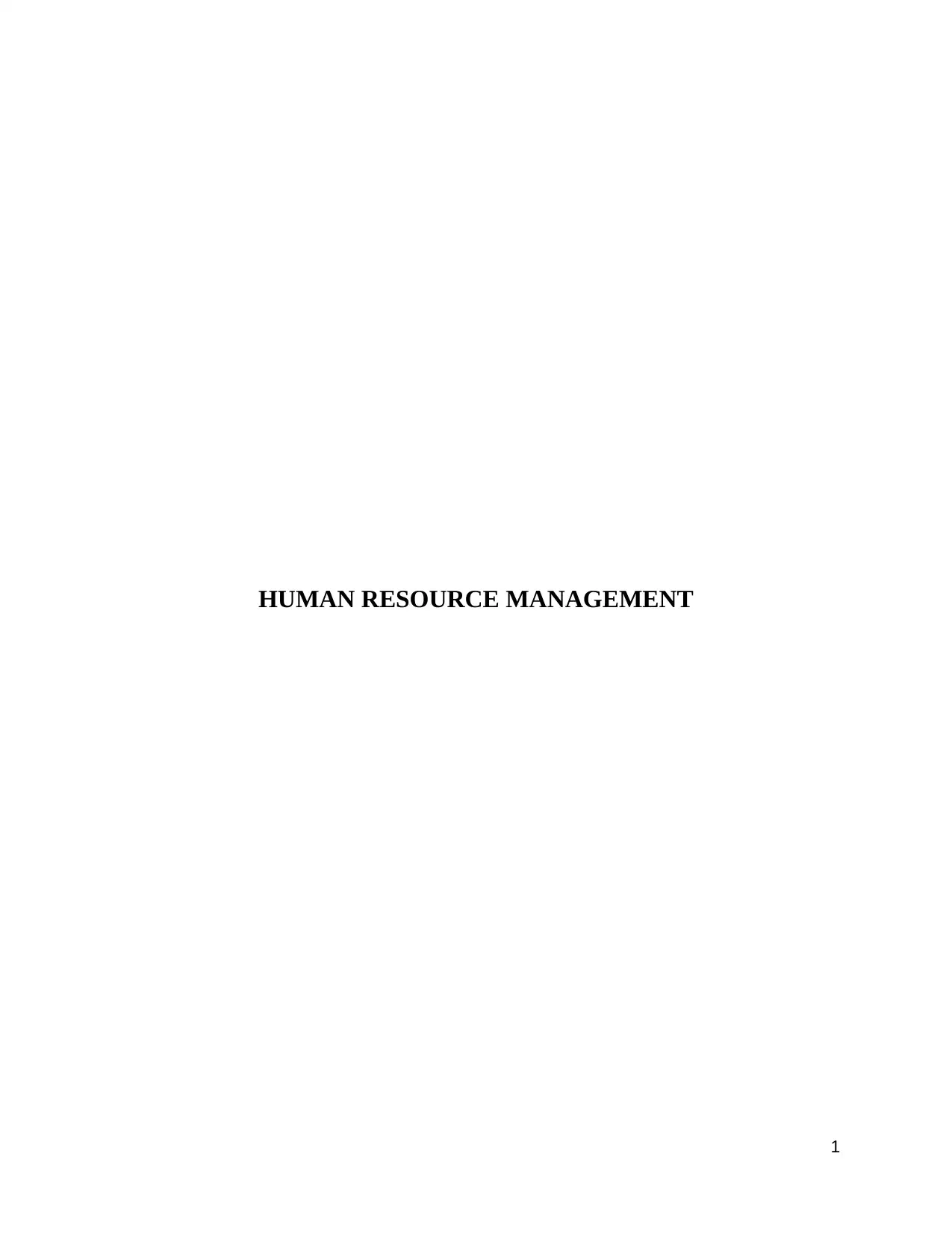
HUMAN RESOURCE MANAGEMENT
1
1
Paraphrase This Document
Need a fresh take? Get an instant paraphrase of this document with our AI Paraphraser
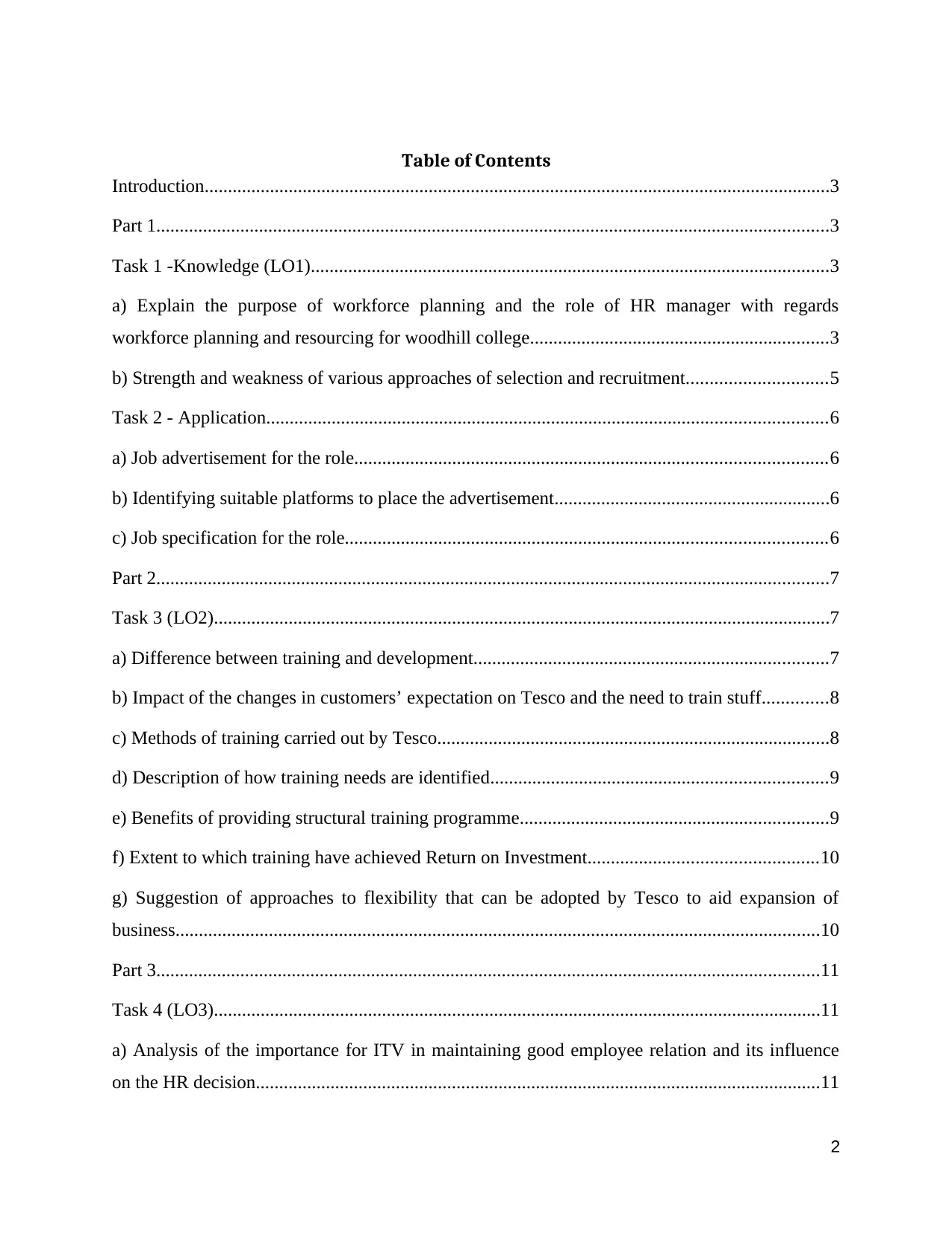
Table of Contents
Introduction......................................................................................................................................3
Part 1................................................................................................................................................3
Task 1 -Knowledge (LO1)...............................................................................................................3
a) Explain the purpose of workforce planning and the role of HR manager with regards
workforce planning and resourcing for woodhill college................................................................3
b) Strength and weakness of various approaches of selection and recruitment..............................5
Task 2 - Application........................................................................................................................6
a) Job advertisement for the role.....................................................................................................6
b) Identifying suitable platforms to place the advertisement...........................................................6
c) Job specification for the role.......................................................................................................6
Part 2................................................................................................................................................7
Task 3 (LO2)....................................................................................................................................7
a) Difference between training and development............................................................................7
b) Impact of the changes in customers’ expectation on Tesco and the need to train stuff..............8
c) Methods of training carried out by Tesco....................................................................................8
d) Description of how training needs are identified........................................................................9
e) Benefits of providing structural training programme..................................................................9
f) Extent to which training have achieved Return on Investment.................................................10
g) Suggestion of approaches to flexibility that can be adopted by Tesco to aid expansion of
business..........................................................................................................................................10
Part 3..............................................................................................................................................11
Task 4 (LO3)..................................................................................................................................11
a) Analysis of the importance for ITV in maintaining good employee relation and its influence
on the HR decision.........................................................................................................................11
2
Introduction......................................................................................................................................3
Part 1................................................................................................................................................3
Task 1 -Knowledge (LO1)...............................................................................................................3
a) Explain the purpose of workforce planning and the role of HR manager with regards
workforce planning and resourcing for woodhill college................................................................3
b) Strength and weakness of various approaches of selection and recruitment..............................5
Task 2 - Application........................................................................................................................6
a) Job advertisement for the role.....................................................................................................6
b) Identifying suitable platforms to place the advertisement...........................................................6
c) Job specification for the role.......................................................................................................6
Part 2................................................................................................................................................7
Task 3 (LO2)....................................................................................................................................7
a) Difference between training and development............................................................................7
b) Impact of the changes in customers’ expectation on Tesco and the need to train stuff..............8
c) Methods of training carried out by Tesco....................................................................................8
d) Description of how training needs are identified........................................................................9
e) Benefits of providing structural training programme..................................................................9
f) Extent to which training have achieved Return on Investment.................................................10
g) Suggestion of approaches to flexibility that can be adopted by Tesco to aid expansion of
business..........................................................................................................................................10
Part 3..............................................................................................................................................11
Task 4 (LO3)..................................................................................................................................11
a) Analysis of the importance for ITV in maintaining good employee relation and its influence
on the HR decision.........................................................................................................................11
2
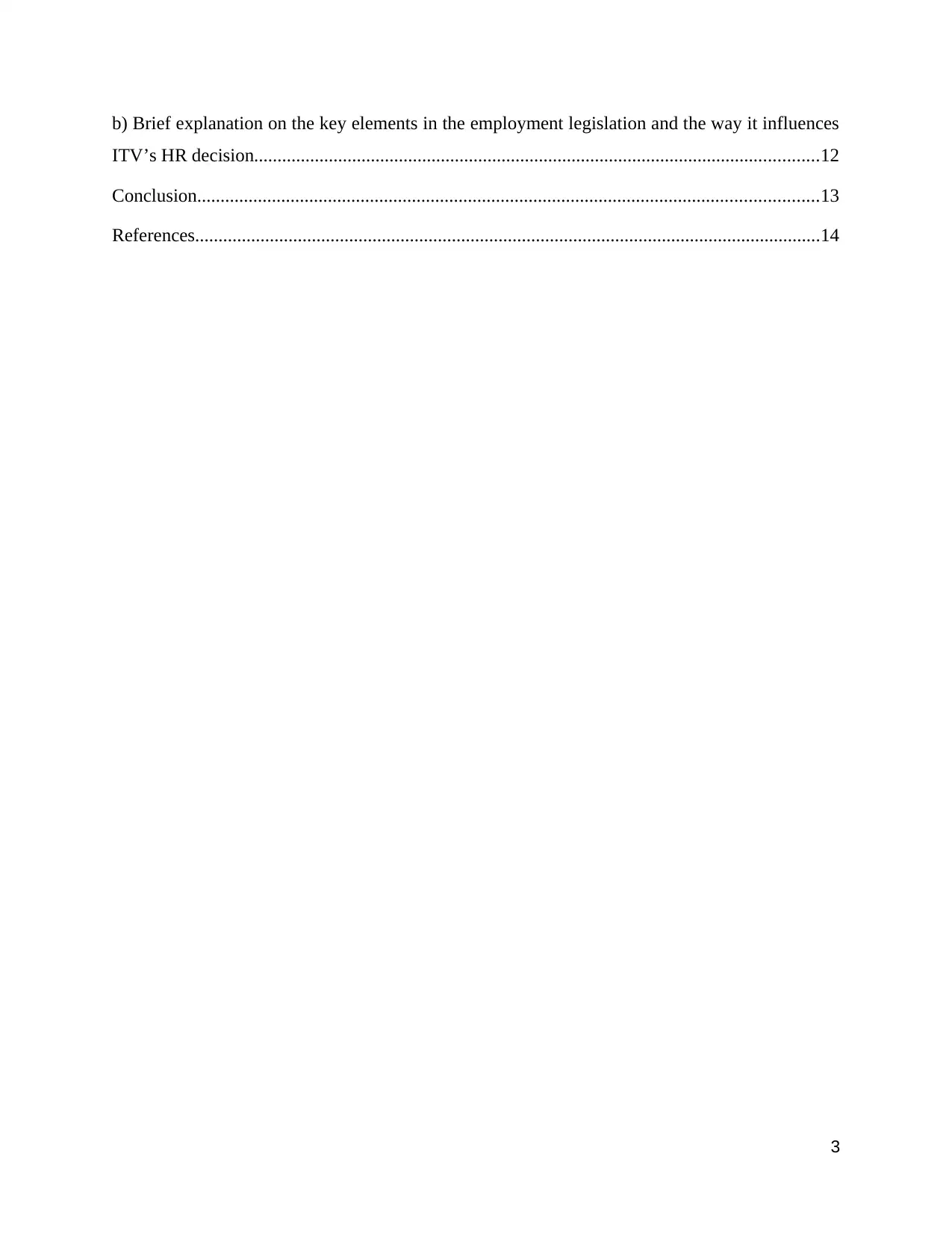
b) Brief explanation on the key elements in the employment legislation and the way it influences
ITV’s HR decision.........................................................................................................................12
Conclusion.....................................................................................................................................13
References......................................................................................................................................14
3
ITV’s HR decision.........................................................................................................................12
Conclusion.....................................................................................................................................13
References......................................................................................................................................14
3
⊘ This is a preview!⊘
Do you want full access?
Subscribe today to unlock all pages.

Trusted by 1+ million students worldwide
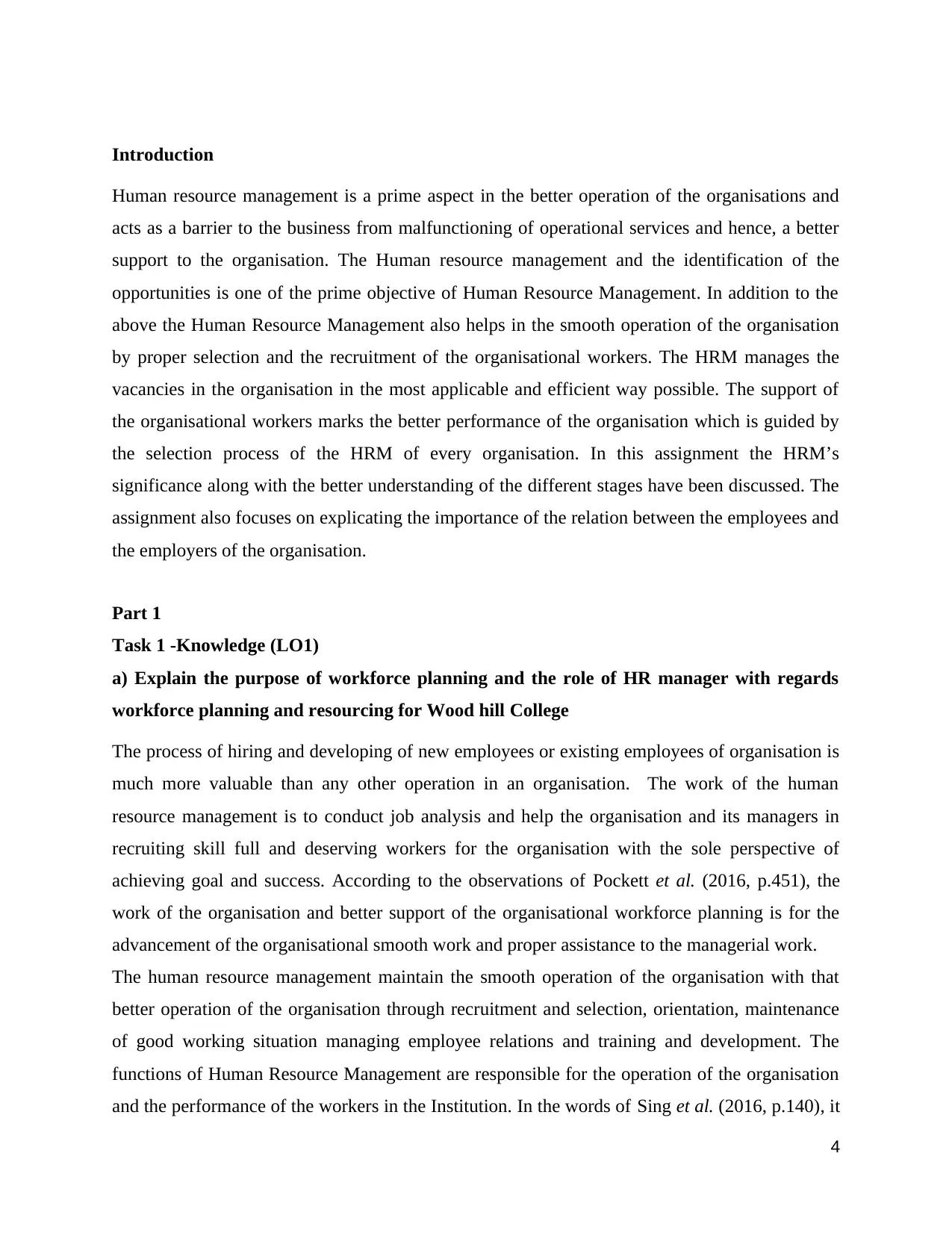
Introduction
Human resource management is a prime aspect in the better operation of the organisations and
acts as a barrier to the business from malfunctioning of operational services and hence, a better
support to the organisation. The Human resource management and the identification of the
opportunities is one of the prime objective of Human Resource Management. In addition to the
above the Human Resource Management also helps in the smooth operation of the organisation
by proper selection and the recruitment of the organisational workers. The HRM manages the
vacancies in the organisation in the most applicable and efficient way possible. The support of
the organisational workers marks the better performance of the organisation which is guided by
the selection process of the HRM of every organisation. In this assignment the HRM’s
significance along with the better understanding of the different stages have been discussed. The
assignment also focuses on explicating the importance of the relation between the employees and
the employers of the organisation.
Part 1
Task 1 -Knowledge (LO1)
a) Explain the purpose of workforce planning and the role of HR manager with regards
workforce planning and resourcing for Wood hill College
The process of hiring and developing of new employees or existing employees of organisation is
much more valuable than any other operation in an organisation. The work of the human
resource management is to conduct job analysis and help the organisation and its managers in
recruiting skill full and deserving workers for the organisation with the sole perspective of
achieving goal and success. According to the observations of Pockett et al. (2016, p.451), the
work of the organisation and better support of the organisational workforce planning is for the
advancement of the organisational smooth work and proper assistance to the managerial work.
The human resource management maintain the smooth operation of the organisation with that
better operation of the organisation through recruitment and selection, orientation, maintenance
of good working situation managing employee relations and training and development. The
functions of Human Resource Management are responsible for the operation of the organisation
and the performance of the workers in the Institution. In the words of Sing et al. (2016, p.140), it
4
Human resource management is a prime aspect in the better operation of the organisations and
acts as a barrier to the business from malfunctioning of operational services and hence, a better
support to the organisation. The Human resource management and the identification of the
opportunities is one of the prime objective of Human Resource Management. In addition to the
above the Human Resource Management also helps in the smooth operation of the organisation
by proper selection and the recruitment of the organisational workers. The HRM manages the
vacancies in the organisation in the most applicable and efficient way possible. The support of
the organisational workers marks the better performance of the organisation which is guided by
the selection process of the HRM of every organisation. In this assignment the HRM’s
significance along with the better understanding of the different stages have been discussed. The
assignment also focuses on explicating the importance of the relation between the employees and
the employers of the organisation.
Part 1
Task 1 -Knowledge (LO1)
a) Explain the purpose of workforce planning and the role of HR manager with regards
workforce planning and resourcing for Wood hill College
The process of hiring and developing of new employees or existing employees of organisation is
much more valuable than any other operation in an organisation. The work of the human
resource management is to conduct job analysis and help the organisation and its managers in
recruiting skill full and deserving workers for the organisation with the sole perspective of
achieving goal and success. According to the observations of Pockett et al. (2016, p.451), the
work of the organisation and better support of the organisational workforce planning is for the
advancement of the organisational smooth work and proper assistance to the managerial work.
The human resource management maintain the smooth operation of the organisation with that
better operation of the organisation through recruitment and selection, orientation, maintenance
of good working situation managing employee relations and training and development. The
functions of Human Resource Management are responsible for the operation of the organisation
and the performance of the workers in the Institution. In the words of Sing et al. (2016, p.140), it
4
Paraphrase This Document
Need a fresh take? Get an instant paraphrase of this document with our AI Paraphraser
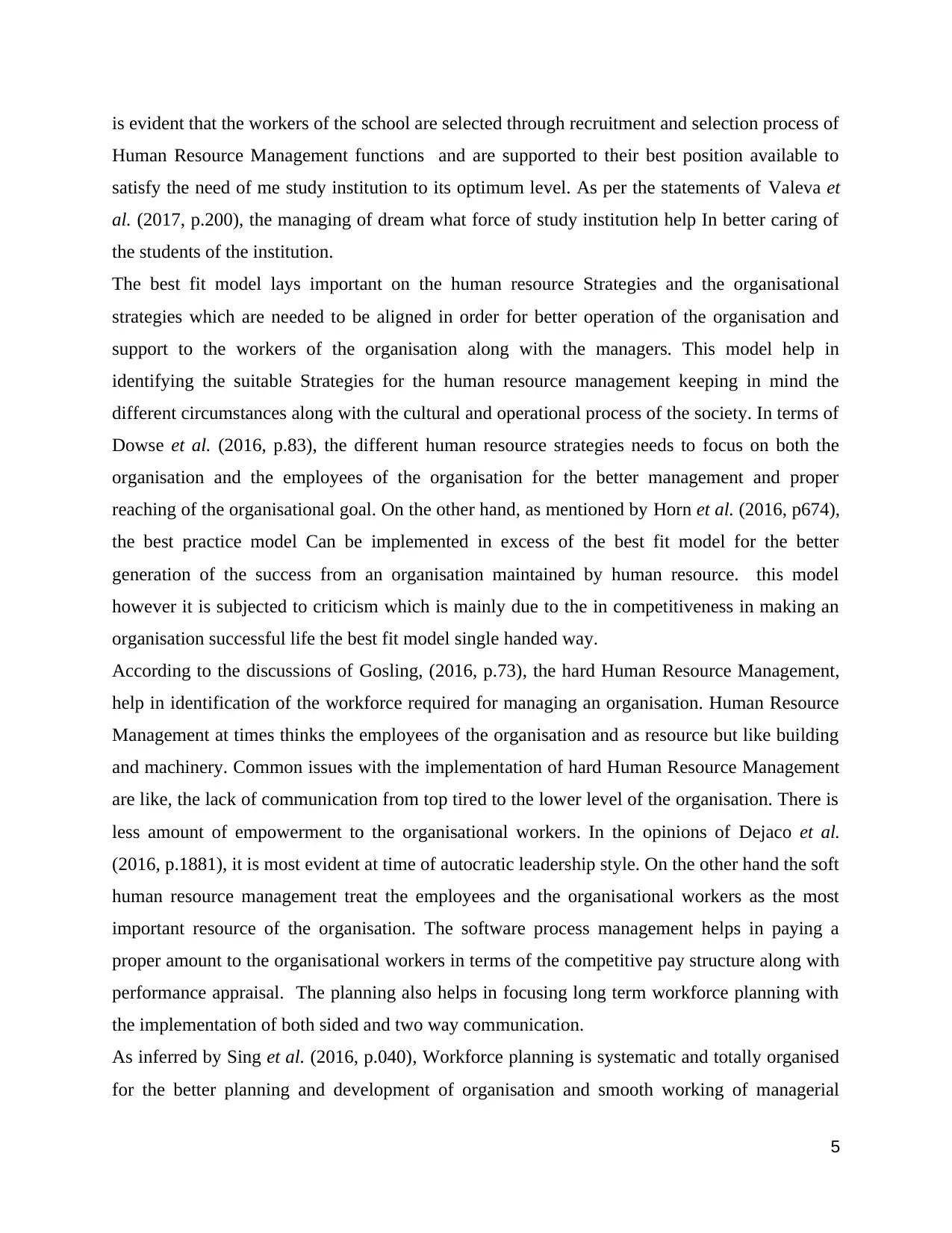
is evident that the workers of the school are selected through recruitment and selection process of
Human Resource Management functions and are supported to their best position available to
satisfy the need of me study institution to its optimum level. As per the statements of Valeva et
al. (2017, p.200), the managing of dream what force of study institution help In better caring of
the students of the institution.
The best fit model lays important on the human resource Strategies and the organisational
strategies which are needed to be aligned in order for better operation of the organisation and
support to the workers of the organisation along with the managers. This model help in
identifying the suitable Strategies for the human resource management keeping in mind the
different circumstances along with the cultural and operational process of the society. In terms of
Dowse et al. (2016, p.83), the different human resource strategies needs to focus on both the
organisation and the employees of the organisation for the better management and proper
reaching of the organisational goal. On the other hand, as mentioned by Horn et al. (2016, p674),
the best practice model Can be implemented in excess of the best fit model for the better
generation of the success from an organisation maintained by human resource. this model
however it is subjected to criticism which is mainly due to the in competitiveness in making an
organisation successful life the best fit model single handed way.
According to the discussions of Gosling, (2016, p.73), the hard Human Resource Management,
help in identification of the workforce required for managing an organisation. Human Resource
Management at times thinks the employees of the organisation and as resource but like building
and machinery. Common issues with the implementation of hard Human Resource Management
are like, the lack of communication from top tired to the lower level of the organisation. There is
less amount of empowerment to the organisational workers. In the opinions of Dejaco et al.
(2016, p.1881), it is most evident at time of autocratic leadership style. On the other hand the soft
human resource management treat the employees and the organisational workers as the most
important resource of the organisation. The software process management helps in paying a
proper amount to the organisational workers in terms of the competitive pay structure along with
performance appraisal. The planning also helps in focusing long term workforce planning with
the implementation of both sided and two way communication.
As inferred by Sing et al. (2016, p.040), Workforce planning is systematic and totally organised
for the better planning and development of organisation and smooth working of managerial
5
Human Resource Management functions and are supported to their best position available to
satisfy the need of me study institution to its optimum level. As per the statements of Valeva et
al. (2017, p.200), the managing of dream what force of study institution help In better caring of
the students of the institution.
The best fit model lays important on the human resource Strategies and the organisational
strategies which are needed to be aligned in order for better operation of the organisation and
support to the workers of the organisation along with the managers. This model help in
identifying the suitable Strategies for the human resource management keeping in mind the
different circumstances along with the cultural and operational process of the society. In terms of
Dowse et al. (2016, p.83), the different human resource strategies needs to focus on both the
organisation and the employees of the organisation for the better management and proper
reaching of the organisational goal. On the other hand, as mentioned by Horn et al. (2016, p674),
the best practice model Can be implemented in excess of the best fit model for the better
generation of the success from an organisation maintained by human resource. this model
however it is subjected to criticism which is mainly due to the in competitiveness in making an
organisation successful life the best fit model single handed way.
According to the discussions of Gosling, (2016, p.73), the hard Human Resource Management,
help in identification of the workforce required for managing an organisation. Human Resource
Management at times thinks the employees of the organisation and as resource but like building
and machinery. Common issues with the implementation of hard Human Resource Management
are like, the lack of communication from top tired to the lower level of the organisation. There is
less amount of empowerment to the organisational workers. In the opinions of Dejaco et al.
(2016, p.1881), it is most evident at time of autocratic leadership style. On the other hand the soft
human resource management treat the employees and the organisational workers as the most
important resource of the organisation. The software process management helps in paying a
proper amount to the organisational workers in terms of the competitive pay structure along with
performance appraisal. The planning also helps in focusing long term workforce planning with
the implementation of both sided and two way communication.
As inferred by Sing et al. (2016, p.040), Workforce planning is systematic and totally organised
for the better planning and development of organisation and smooth working of managerial
5
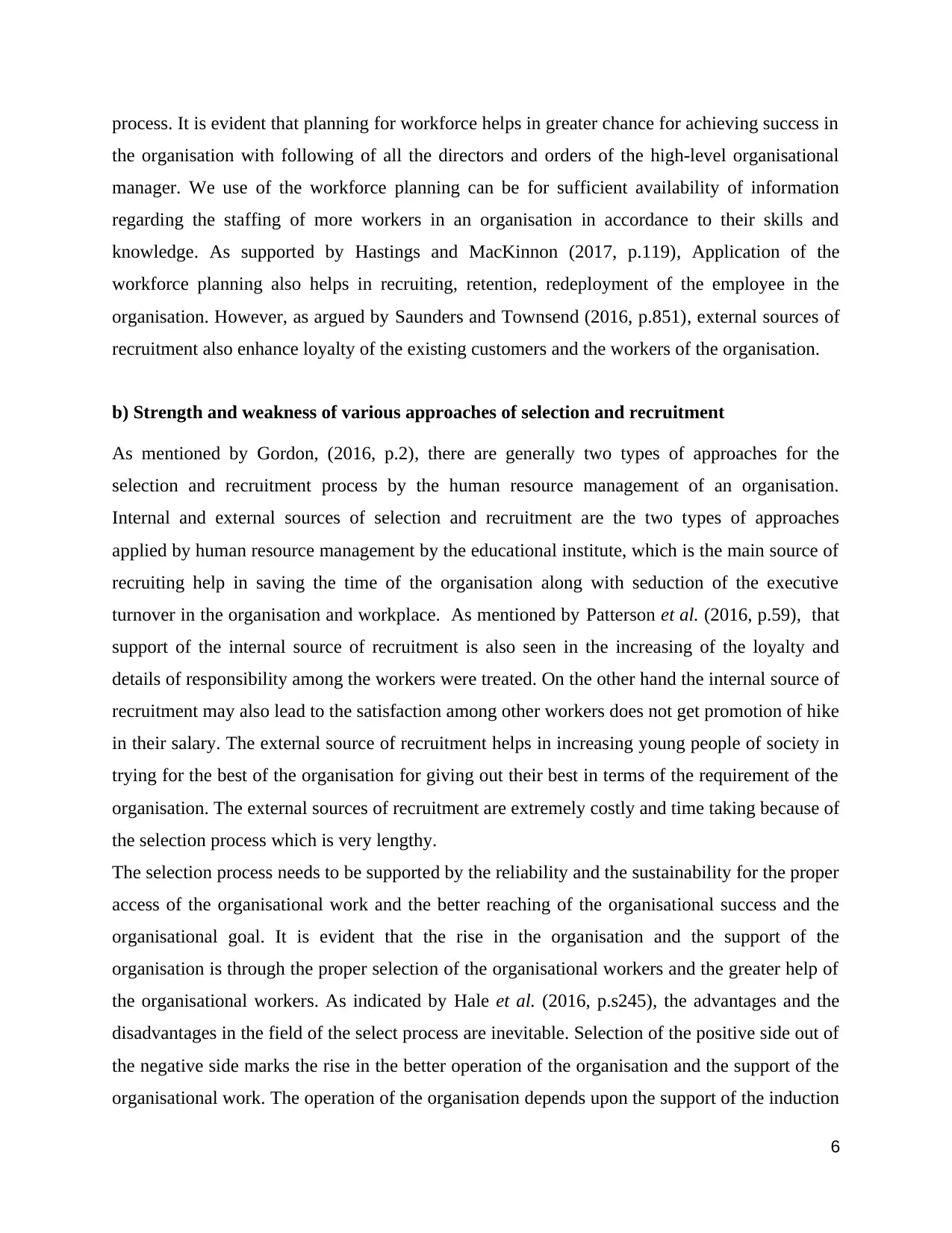
process. It is evident that planning for workforce helps in greater chance for achieving success in
the organisation with following of all the directors and orders of the high-level organisational
manager. We use of the workforce planning can be for sufficient availability of information
regarding the staffing of more workers in an organisation in accordance to their skills and
knowledge. As supported by Hastings and MacKinnon (2017, p.119), Application of the
workforce planning also helps in recruiting, retention, redeployment of the employee in the
organisation. However, as argued by Saunders and Townsend (2016, p.851), external sources of
recruitment also enhance loyalty of the existing customers and the workers of the organisation.
b) Strength and weakness of various approaches of selection and recruitment
As mentioned by Gordon, (2016, p.2), there are generally two types of approaches for the
selection and recruitment process by the human resource management of an organisation.
Internal and external sources of selection and recruitment are the two types of approaches
applied by human resource management by the educational institute, which is the main source of
recruiting help in saving the time of the organisation along with seduction of the executive
turnover in the organisation and workplace. As mentioned by Patterson et al. (2016, p.59), that
support of the internal source of recruitment is also seen in the increasing of the loyalty and
details of responsibility among the workers were treated. On the other hand the internal source of
recruitment may also lead to the satisfaction among other workers does not get promotion of hike
in their salary. The external source of recruitment helps in increasing young people of society in
trying for the best of the organisation for giving out their best in terms of the requirement of the
organisation. The external sources of recruitment are extremely costly and time taking because of
the selection process which is very lengthy.
The selection process needs to be supported by the reliability and the sustainability for the proper
access of the organisational work and the better reaching of the organisational success and the
organisational goal. It is evident that the rise in the organisation and the support of the
organisation is through the proper selection of the organisational workers and the greater help of
the organisational workers. As indicated by Hale et al. (2016, p.s245), the advantages and the
disadvantages in the field of the select process are inevitable. Selection of the positive side out of
the negative side marks the rise in the better operation of the organisation and the support of the
organisational work. The operation of the organisation depends upon the support of the induction
6
the organisation with following of all the directors and orders of the high-level organisational
manager. We use of the workforce planning can be for sufficient availability of information
regarding the staffing of more workers in an organisation in accordance to their skills and
knowledge. As supported by Hastings and MacKinnon (2017, p.119), Application of the
workforce planning also helps in recruiting, retention, redeployment of the employee in the
organisation. However, as argued by Saunders and Townsend (2016, p.851), external sources of
recruitment also enhance loyalty of the existing customers and the workers of the organisation.
b) Strength and weakness of various approaches of selection and recruitment
As mentioned by Gordon, (2016, p.2), there are generally two types of approaches for the
selection and recruitment process by the human resource management of an organisation.
Internal and external sources of selection and recruitment are the two types of approaches
applied by human resource management by the educational institute, which is the main source of
recruiting help in saving the time of the organisation along with seduction of the executive
turnover in the organisation and workplace. As mentioned by Patterson et al. (2016, p.59), that
support of the internal source of recruitment is also seen in the increasing of the loyalty and
details of responsibility among the workers were treated. On the other hand the internal source of
recruitment may also lead to the satisfaction among other workers does not get promotion of hike
in their salary. The external source of recruitment helps in increasing young people of society in
trying for the best of the organisation for giving out their best in terms of the requirement of the
organisation. The external sources of recruitment are extremely costly and time taking because of
the selection process which is very lengthy.
The selection process needs to be supported by the reliability and the sustainability for the proper
access of the organisational work and the better reaching of the organisational success and the
organisational goal. It is evident that the rise in the organisation and the support of the
organisation is through the proper selection of the organisational workers and the greater help of
the organisational workers. As indicated by Hale et al. (2016, p.s245), the advantages and the
disadvantages in the field of the select process are inevitable. Selection of the positive side out of
the negative side marks the rise in the better operation of the organisation and the support of the
organisational work. The operation of the organisation depends upon the support of the induction
6
⊘ This is a preview!⊘
Do you want full access?
Subscribe today to unlock all pages.

Trusted by 1+ million students worldwide
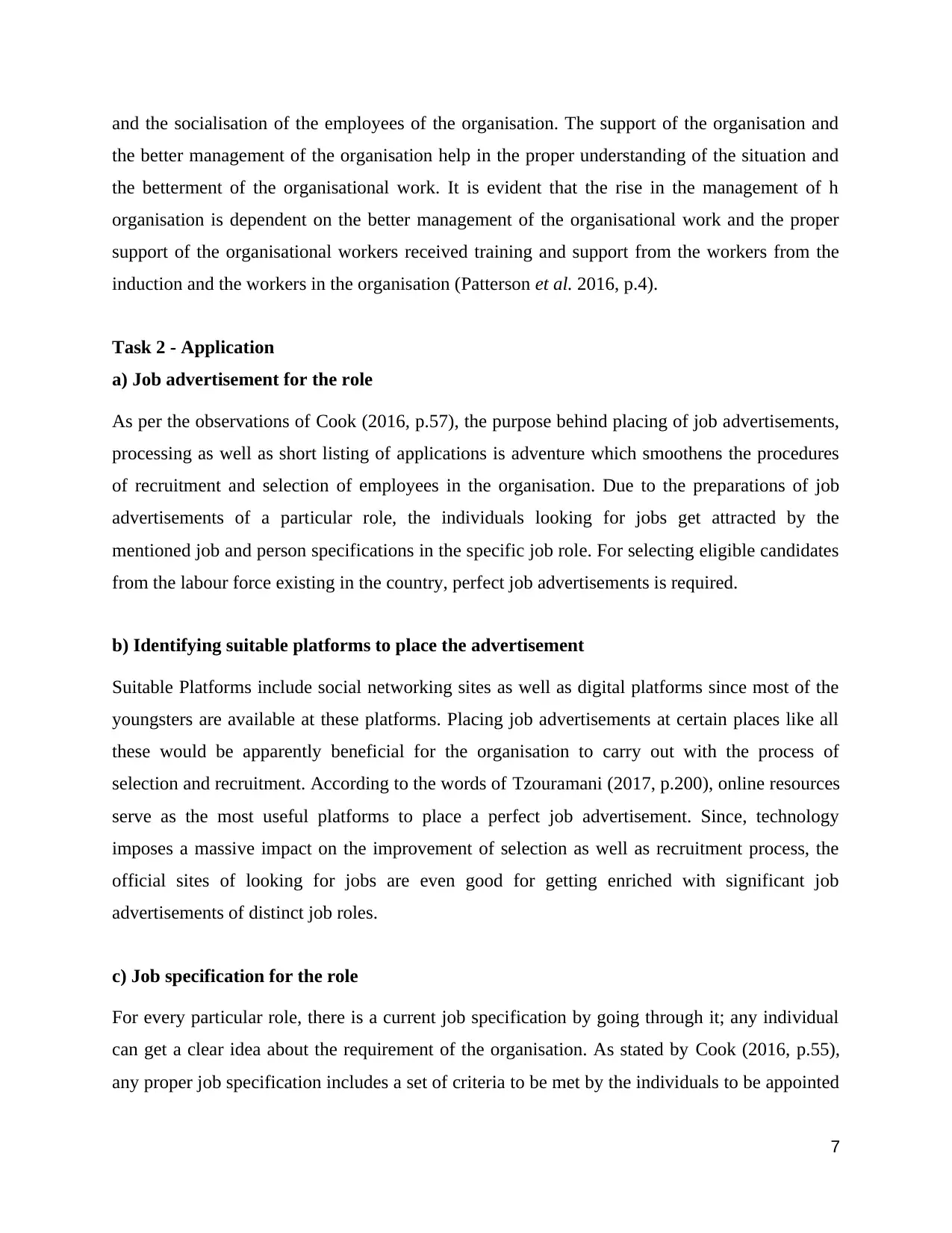
and the socialisation of the employees of the organisation. The support of the organisation and
the better management of the organisation help in the proper understanding of the situation and
the betterment of the organisational work. It is evident that the rise in the management of h
organisation is dependent on the better management of the organisational work and the proper
support of the organisational workers received training and support from the workers from the
induction and the workers in the organisation (Patterson et al. 2016, p.4).
Task 2 - Application
a) Job advertisement for the role
As per the observations of Cook (2016, p.57), the purpose behind placing of job advertisements,
processing as well as short listing of applications is adventure which smoothens the procedures
of recruitment and selection of employees in the organisation. Due to the preparations of job
advertisements of a particular role, the individuals looking for jobs get attracted by the
mentioned job and person specifications in the specific job role. For selecting eligible candidates
from the labour force existing in the country, perfect job advertisements is required.
b) Identifying suitable platforms to place the advertisement
Suitable Platforms include social networking sites as well as digital platforms since most of the
youngsters are available at these platforms. Placing job advertisements at certain places like all
these would be apparently beneficial for the organisation to carry out with the process of
selection and recruitment. According to the words of Tzouramani (2017, p.200), online resources
serve as the most useful platforms to place a perfect job advertisement. Since, technology
imposes a massive impact on the improvement of selection as well as recruitment process, the
official sites of looking for jobs are even good for getting enriched with significant job
advertisements of distinct job roles.
c) Job specification for the role
For every particular role, there is a current job specification by going through it; any individual
can get a clear idea about the requirement of the organisation. As stated by Cook (2016, p.55),
any proper job specification includes a set of criteria to be met by the individuals to be appointed
7
the better management of the organisation help in the proper understanding of the situation and
the betterment of the organisational work. It is evident that the rise in the management of h
organisation is dependent on the better management of the organisational work and the proper
support of the organisational workers received training and support from the workers from the
induction and the workers in the organisation (Patterson et al. 2016, p.4).
Task 2 - Application
a) Job advertisement for the role
As per the observations of Cook (2016, p.57), the purpose behind placing of job advertisements,
processing as well as short listing of applications is adventure which smoothens the procedures
of recruitment and selection of employees in the organisation. Due to the preparations of job
advertisements of a particular role, the individuals looking for jobs get attracted by the
mentioned job and person specifications in the specific job role. For selecting eligible candidates
from the labour force existing in the country, perfect job advertisements is required.
b) Identifying suitable platforms to place the advertisement
Suitable Platforms include social networking sites as well as digital platforms since most of the
youngsters are available at these platforms. Placing job advertisements at certain places like all
these would be apparently beneficial for the organisation to carry out with the process of
selection and recruitment. According to the words of Tzouramani (2017, p.200), online resources
serve as the most useful platforms to place a perfect job advertisement. Since, technology
imposes a massive impact on the improvement of selection as well as recruitment process, the
official sites of looking for jobs are even good for getting enriched with significant job
advertisements of distinct job roles.
c) Job specification for the role
For every particular role, there is a current job specification by going through it; any individual
can get a clear idea about the requirement of the organisation. As stated by Cook (2016, p.55),
any proper job specification includes a set of criteria to be met by the individuals to be appointed
7
Paraphrase This Document
Need a fresh take? Get an instant paraphrase of this document with our AI Paraphraser
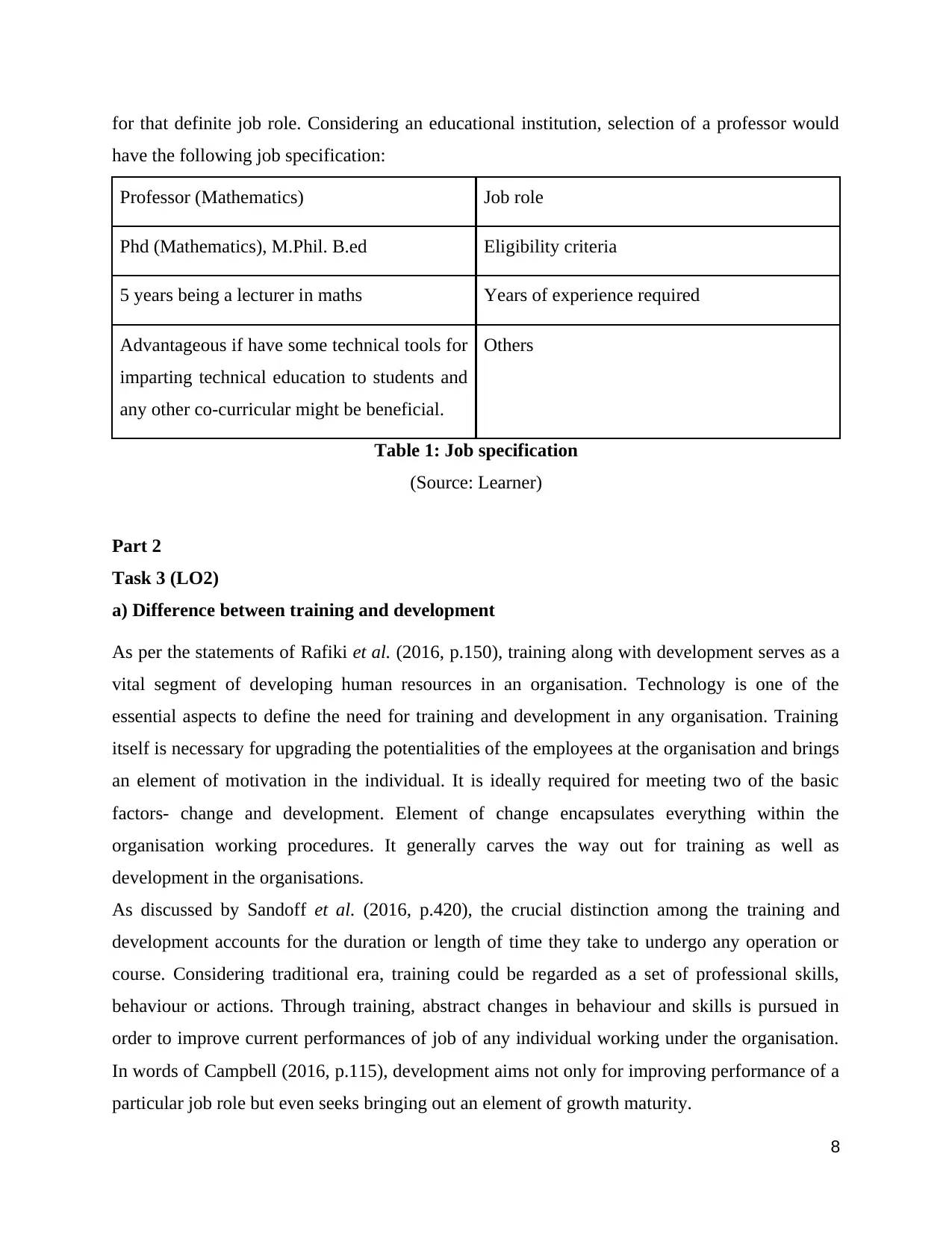
for that definite job role. Considering an educational institution, selection of a professor would
have the following job specification:
Job roleProfessor (Mathematics)
Eligibility criteriaPhd (Mathematics), M.Phil. B.ed
Years of experience required5 years being a lecturer in maths
OthersAdvantageous if have some technical tools for
imparting technical education to students and
any other co-curricular might be beneficial.
Table 1: Job specification
(Source: Learner)
Part 2
Task 3 (LO2)
a) Difference between training and development
As per the statements of Rafiki et al. (2016, p.150), training along with development serves as a
vital segment of developing human resources in an organisation. Technology is one of the
essential aspects to define the need for training and development in any organisation. Training
itself is necessary for upgrading the potentialities of the employees at the organisation and brings
an element of motivation in the individual. It is ideally required for meeting two of the basic
factors- change and development. Element of change encapsulates everything within the
organisation working procedures. It generally carves the way out for training as well as
development in the organisations.
As discussed by Sandoff et al. (2016, p.420), the crucial distinction among the training and
development accounts for the duration or length of time they take to undergo any operation or
course. Considering traditional era, training could be regarded as a set of professional skills,
behaviour or actions. Through training, abstract changes in behaviour and skills is pursued in
order to improve current performances of job of any individual working under the organisation.
In words of Campbell (2016, p.115), development aims not only for improving performance of a
particular job role but even seeks bringing out an element of growth maturity.
8
have the following job specification:
Job roleProfessor (Mathematics)
Eligibility criteriaPhd (Mathematics), M.Phil. B.ed
Years of experience required5 years being a lecturer in maths
OthersAdvantageous if have some technical tools for
imparting technical education to students and
any other co-curricular might be beneficial.
Table 1: Job specification
(Source: Learner)
Part 2
Task 3 (LO2)
a) Difference between training and development
As per the statements of Rafiki et al. (2016, p.150), training along with development serves as a
vital segment of developing human resources in an organisation. Technology is one of the
essential aspects to define the need for training and development in any organisation. Training
itself is necessary for upgrading the potentialities of the employees at the organisation and brings
an element of motivation in the individual. It is ideally required for meeting two of the basic
factors- change and development. Element of change encapsulates everything within the
organisation working procedures. It generally carves the way out for training as well as
development in the organisations.
As discussed by Sandoff et al. (2016, p.420), the crucial distinction among the training and
development accounts for the duration or length of time they take to undergo any operation or
course. Considering traditional era, training could be regarded as a set of professional skills,
behaviour or actions. Through training, abstract changes in behaviour and skills is pursued in
order to improve current performances of job of any individual working under the organisation.
In words of Campbell (2016, p.115), development aims not only for improving performance of a
particular job role but even seeks bringing out an element of growth maturity.
8
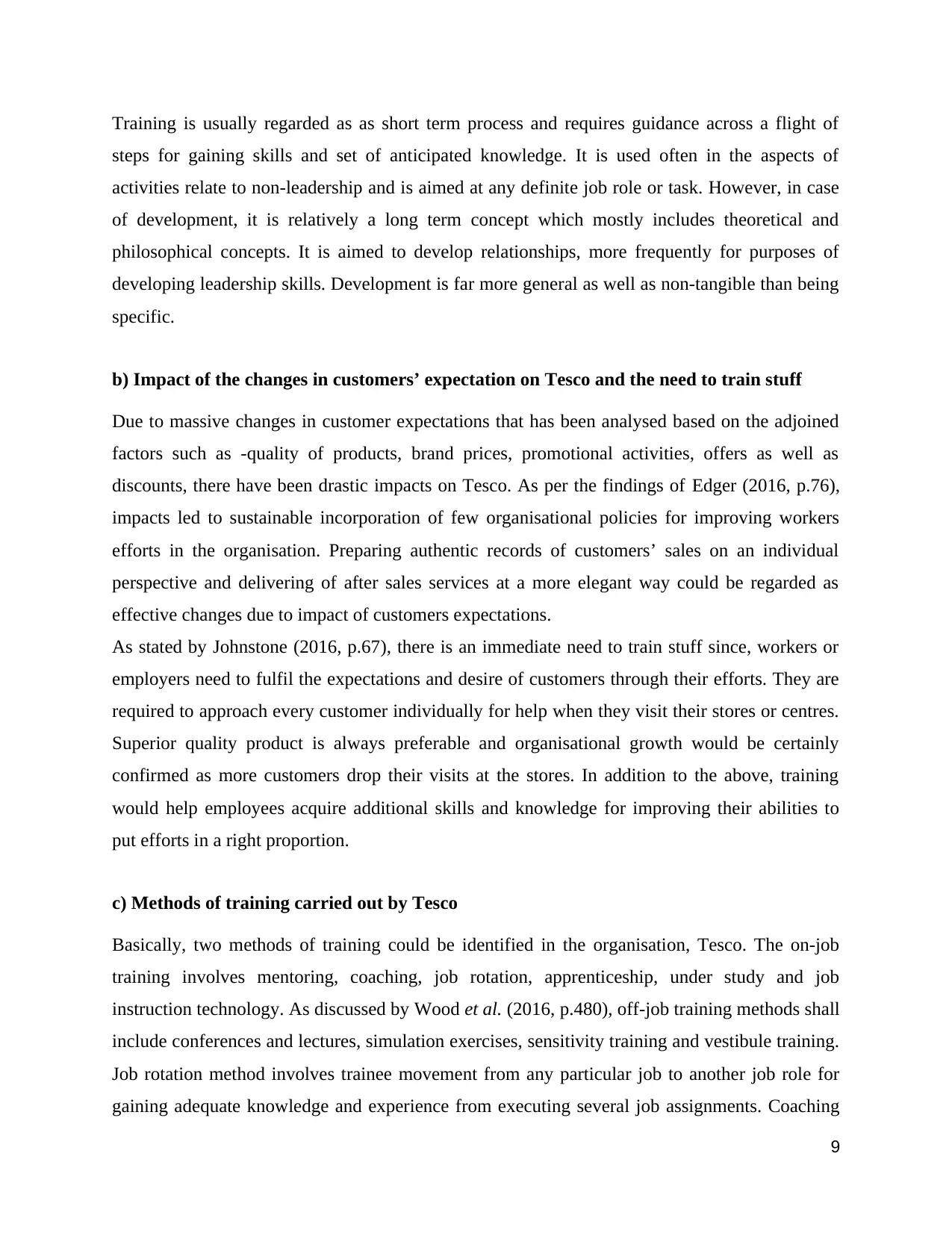
Training is usually regarded as as short term process and requires guidance across a flight of
steps for gaining skills and set of anticipated knowledge. It is used often in the aspects of
activities relate to non-leadership and is aimed at any definite job role or task. However, in case
of development, it is relatively a long term concept which mostly includes theoretical and
philosophical concepts. It is aimed to develop relationships, more frequently for purposes of
developing leadership skills. Development is far more general as well as non-tangible than being
specific.
b) Impact of the changes in customers’ expectation on Tesco and the need to train stuff
Due to massive changes in customer expectations that has been analysed based on the adjoined
factors such as -quality of products, brand prices, promotional activities, offers as well as
discounts, there have been drastic impacts on Tesco. As per the findings of Edger (2016, p.76),
impacts led to sustainable incorporation of few organisational policies for improving workers
efforts in the organisation. Preparing authentic records of customers’ sales on an individual
perspective and delivering of after sales services at a more elegant way could be regarded as
effective changes due to impact of customers expectations.
As stated by Johnstone (2016, p.67), there is an immediate need to train stuff since, workers or
employers need to fulfil the expectations and desire of customers through their efforts. They are
required to approach every customer individually for help when they visit their stores or centres.
Superior quality product is always preferable and organisational growth would be certainly
confirmed as more customers drop their visits at the stores. In addition to the above, training
would help employees acquire additional skills and knowledge for improving their abilities to
put efforts in a right proportion.
c) Methods of training carried out by Tesco
Basically, two methods of training could be identified in the organisation, Tesco. The on-job
training involves mentoring, coaching, job rotation, apprenticeship, under study and job
instruction technology. As discussed by Wood et al. (2016, p.480), off-job training methods shall
include conferences and lectures, simulation exercises, sensitivity training and vestibule training.
Job rotation method involves trainee movement from any particular job to another job role for
gaining adequate knowledge and experience from executing several job assignments. Coaching
9
steps for gaining skills and set of anticipated knowledge. It is used often in the aspects of
activities relate to non-leadership and is aimed at any definite job role or task. However, in case
of development, it is relatively a long term concept which mostly includes theoretical and
philosophical concepts. It is aimed to develop relationships, more frequently for purposes of
developing leadership skills. Development is far more general as well as non-tangible than being
specific.
b) Impact of the changes in customers’ expectation on Tesco and the need to train stuff
Due to massive changes in customer expectations that has been analysed based on the adjoined
factors such as -quality of products, brand prices, promotional activities, offers as well as
discounts, there have been drastic impacts on Tesco. As per the findings of Edger (2016, p.76),
impacts led to sustainable incorporation of few organisational policies for improving workers
efforts in the organisation. Preparing authentic records of customers’ sales on an individual
perspective and delivering of after sales services at a more elegant way could be regarded as
effective changes due to impact of customers expectations.
As stated by Johnstone (2016, p.67), there is an immediate need to train stuff since, workers or
employers need to fulfil the expectations and desire of customers through their efforts. They are
required to approach every customer individually for help when they visit their stores or centres.
Superior quality product is always preferable and organisational growth would be certainly
confirmed as more customers drop their visits at the stores. In addition to the above, training
would help employees acquire additional skills and knowledge for improving their abilities to
put efforts in a right proportion.
c) Methods of training carried out by Tesco
Basically, two methods of training could be identified in the organisation, Tesco. The on-job
training involves mentoring, coaching, job rotation, apprenticeship, under study and job
instruction technology. As discussed by Wood et al. (2016, p.480), off-job training methods shall
include conferences and lectures, simulation exercises, sensitivity training and vestibule training.
Job rotation method involves trainee movement from any particular job to another job role for
gaining adequate knowledge and experience from executing several job assignments. Coaching
9
⊘ This is a preview!⊘
Do you want full access?
Subscribe today to unlock all pages.

Trusted by 1+ million students worldwide
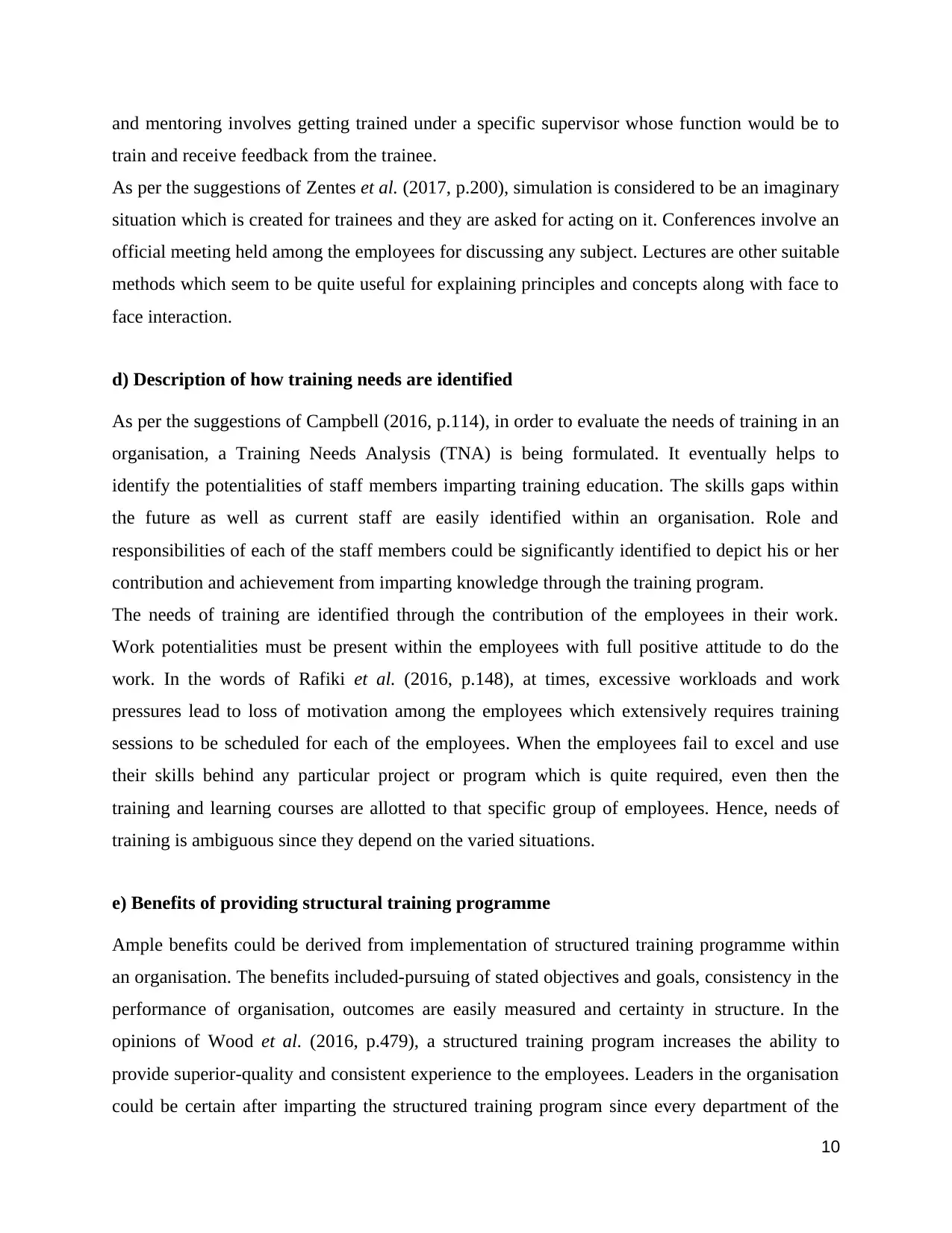
and mentoring involves getting trained under a specific supervisor whose function would be to
train and receive feedback from the trainee.
As per the suggestions of Zentes et al. (2017, p.200), simulation is considered to be an imaginary
situation which is created for trainees and they are asked for acting on it. Conferences involve an
official meeting held among the employees for discussing any subject. Lectures are other suitable
methods which seem to be quite useful for explaining principles and concepts along with face to
face interaction.
d) Description of how training needs are identified
As per the suggestions of Campbell (2016, p.114), in order to evaluate the needs of training in an
organisation, a Training Needs Analysis (TNA) is being formulated. It eventually helps to
identify the potentialities of staff members imparting training education. The skills gaps within
the future as well as current staff are easily identified within an organisation. Role and
responsibilities of each of the staff members could be significantly identified to depict his or her
contribution and achievement from imparting knowledge through the training program.
The needs of training are identified through the contribution of the employees in their work.
Work potentialities must be present within the employees with full positive attitude to do the
work. In the words of Rafiki et al. (2016, p.148), at times, excessive workloads and work
pressures lead to loss of motivation among the employees which extensively requires training
sessions to be scheduled for each of the employees. When the employees fail to excel and use
their skills behind any particular project or program which is quite required, even then the
training and learning courses are allotted to that specific group of employees. Hence, needs of
training is ambiguous since they depend on the varied situations.
e) Benefits of providing structural training programme
Ample benefits could be derived from implementation of structured training programme within
an organisation. The benefits included-pursuing of stated objectives and goals, consistency in the
performance of organisation, outcomes are easily measured and certainty in structure. In the
opinions of Wood et al. (2016, p.479), a structured training program increases the ability to
provide superior-quality and consistent experience to the employees. Leaders in the organisation
could be certain after imparting the structured training program since every department of the
10
train and receive feedback from the trainee.
As per the suggestions of Zentes et al. (2017, p.200), simulation is considered to be an imaginary
situation which is created for trainees and they are asked for acting on it. Conferences involve an
official meeting held among the employees for discussing any subject. Lectures are other suitable
methods which seem to be quite useful for explaining principles and concepts along with face to
face interaction.
d) Description of how training needs are identified
As per the suggestions of Campbell (2016, p.114), in order to evaluate the needs of training in an
organisation, a Training Needs Analysis (TNA) is being formulated. It eventually helps to
identify the potentialities of staff members imparting training education. The skills gaps within
the future as well as current staff are easily identified within an organisation. Role and
responsibilities of each of the staff members could be significantly identified to depict his or her
contribution and achievement from imparting knowledge through the training program.
The needs of training are identified through the contribution of the employees in their work.
Work potentialities must be present within the employees with full positive attitude to do the
work. In the words of Rafiki et al. (2016, p.148), at times, excessive workloads and work
pressures lead to loss of motivation among the employees which extensively requires training
sessions to be scheduled for each of the employees. When the employees fail to excel and use
their skills behind any particular project or program which is quite required, even then the
training and learning courses are allotted to that specific group of employees. Hence, needs of
training is ambiguous since they depend on the varied situations.
e) Benefits of providing structural training programme
Ample benefits could be derived from implementation of structured training programme within
an organisation. The benefits included-pursuing of stated objectives and goals, consistency in the
performance of organisation, outcomes are easily measured and certainty in structure. In the
opinions of Wood et al. (2016, p.479), a structured training program increases the ability to
provide superior-quality and consistent experience to the employees. Leaders in the organisation
could be certain after imparting the structured training program since every department of the
10
Paraphrase This Document
Need a fresh take? Get an instant paraphrase of this document with our AI Paraphraser
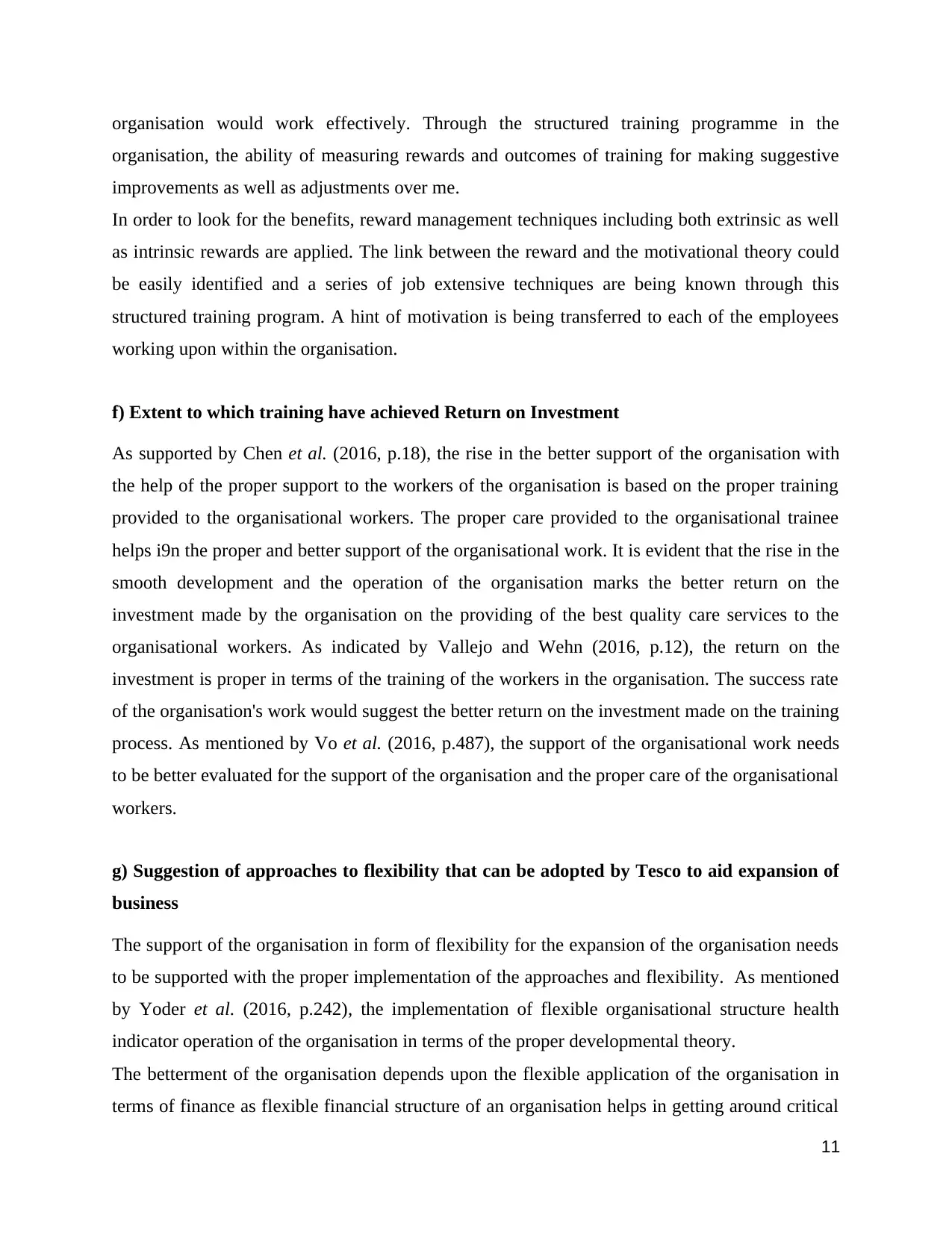
organisation would work effectively. Through the structured training programme in the
organisation, the ability of measuring rewards and outcomes of training for making suggestive
improvements as well as adjustments over me.
In order to look for the benefits, reward management techniques including both extrinsic as well
as intrinsic rewards are applied. The link between the reward and the motivational theory could
be easily identified and a series of job extensive techniques are being known through this
structured training program. A hint of motivation is being transferred to each of the employees
working upon within the organisation.
f) Extent to which training have achieved Return on Investment
As supported by Chen et al. (2016, p.18), the rise in the better support of the organisation with
the help of the proper support to the workers of the organisation is based on the proper training
provided to the organisational workers. The proper care provided to the organisational trainee
helps i9n the proper and better support of the organisational work. It is evident that the rise in the
smooth development and the operation of the organisation marks the better return on the
investment made by the organisation on the providing of the best quality care services to the
organisational workers. As indicated by Vallejo and Wehn (2016, p.12), the return on the
investment is proper in terms of the training of the workers in the organisation. The success rate
of the organisation's work would suggest the better return on the investment made on the training
process. As mentioned by Vo et al. (2016, p.487), the support of the organisational work needs
to be better evaluated for the support of the organisation and the proper care of the organisational
workers.
g) Suggestion of approaches to flexibility that can be adopted by Tesco to aid expansion of
business
The support of the organisation in form of flexibility for the expansion of the organisation needs
to be supported with the proper implementation of the approaches and flexibility. As mentioned
by Yoder et al. (2016, p.242), the implementation of flexible organisational structure health
indicator operation of the organisation in terms of the proper developmental theory.
The betterment of the organisation depends upon the flexible application of the organisation in
terms of finance as flexible financial structure of an organisation helps in getting around critical
11
organisation, the ability of measuring rewards and outcomes of training for making suggestive
improvements as well as adjustments over me.
In order to look for the benefits, reward management techniques including both extrinsic as well
as intrinsic rewards are applied. The link between the reward and the motivational theory could
be easily identified and a series of job extensive techniques are being known through this
structured training program. A hint of motivation is being transferred to each of the employees
working upon within the organisation.
f) Extent to which training have achieved Return on Investment
As supported by Chen et al. (2016, p.18), the rise in the better support of the organisation with
the help of the proper support to the workers of the organisation is based on the proper training
provided to the organisational workers. The proper care provided to the organisational trainee
helps i9n the proper and better support of the organisational work. It is evident that the rise in the
smooth development and the operation of the organisation marks the better return on the
investment made by the organisation on the providing of the best quality care services to the
organisational workers. As indicated by Vallejo and Wehn (2016, p.12), the return on the
investment is proper in terms of the training of the workers in the organisation. The success rate
of the organisation's work would suggest the better return on the investment made on the training
process. As mentioned by Vo et al. (2016, p.487), the support of the organisational work needs
to be better evaluated for the support of the organisation and the proper care of the organisational
workers.
g) Suggestion of approaches to flexibility that can be adopted by Tesco to aid expansion of
business
The support of the organisation in form of flexibility for the expansion of the organisation needs
to be supported with the proper implementation of the approaches and flexibility. As mentioned
by Yoder et al. (2016, p.242), the implementation of flexible organisational structure health
indicator operation of the organisation in terms of the proper developmental theory.
The betterment of the organisation depends upon the flexible application of the organisation in
terms of finance as flexible financial structure of an organisation helps in getting around critical
11
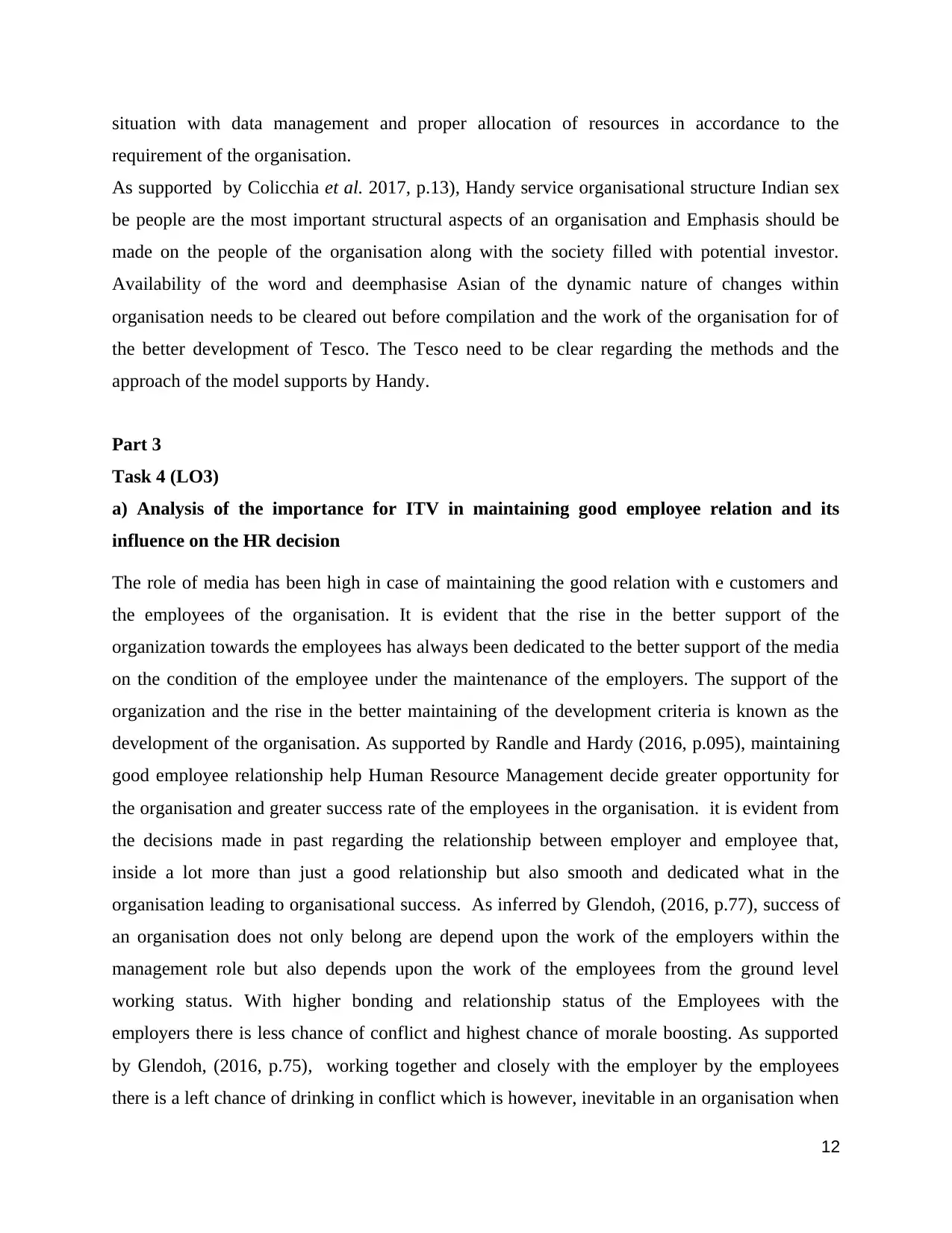
situation with data management and proper allocation of resources in accordance to the
requirement of the organisation.
As supported by Colicchia et al. 2017, p.13), Handy service organisational structure Indian sex
be people are the most important structural aspects of an organisation and Emphasis should be
made on the people of the organisation along with the society filled with potential investor.
Availability of the word and deemphasise Asian of the dynamic nature of changes within
organisation needs to be cleared out before compilation and the work of the organisation for of
the better development of Tesco. The Tesco need to be clear regarding the methods and the
approach of the model supports by Handy.
Part 3
Task 4 (LO3)
a) Analysis of the importance for ITV in maintaining good employee relation and its
influence on the HR decision
The role of media has been high in case of maintaining the good relation with e customers and
the employees of the organisation. It is evident that the rise in the better support of the
organization towards the employees has always been dedicated to the better support of the media
on the condition of the employee under the maintenance of the employers. The support of the
organization and the rise in the better maintaining of the development criteria is known as the
development of the organisation. As supported by Randle and Hardy (2016, p.095), maintaining
good employee relationship help Human Resource Management decide greater opportunity for
the organisation and greater success rate of the employees in the organisation. it is evident from
the decisions made in past regarding the relationship between employer and employee that,
inside a lot more than just a good relationship but also smooth and dedicated what in the
organisation leading to organisational success. As inferred by Glendoh, (2016, p.77), success of
an organisation does not only belong are depend upon the work of the employers within the
management role but also depends upon the work of the employees from the ground level
working status. With higher bonding and relationship status of the Employees with the
employers there is less chance of conflict and highest chance of morale boosting. As supported
by Glendoh, (2016, p.75), working together and closely with the employer by the employees
there is a left chance of drinking in conflict which is however, inevitable in an organisation when
12
requirement of the organisation.
As supported by Colicchia et al. 2017, p.13), Handy service organisational structure Indian sex
be people are the most important structural aspects of an organisation and Emphasis should be
made on the people of the organisation along with the society filled with potential investor.
Availability of the word and deemphasise Asian of the dynamic nature of changes within
organisation needs to be cleared out before compilation and the work of the organisation for of
the better development of Tesco. The Tesco need to be clear regarding the methods and the
approach of the model supports by Handy.
Part 3
Task 4 (LO3)
a) Analysis of the importance for ITV in maintaining good employee relation and its
influence on the HR decision
The role of media has been high in case of maintaining the good relation with e customers and
the employees of the organisation. It is evident that the rise in the better support of the
organization towards the employees has always been dedicated to the better support of the media
on the condition of the employee under the maintenance of the employers. The support of the
organization and the rise in the better maintaining of the development criteria is known as the
development of the organisation. As supported by Randle and Hardy (2016, p.095), maintaining
good employee relationship help Human Resource Management decide greater opportunity for
the organisation and greater success rate of the employees in the organisation. it is evident from
the decisions made in past regarding the relationship between employer and employee that,
inside a lot more than just a good relationship but also smooth and dedicated what in the
organisation leading to organisational success. As inferred by Glendoh, (2016, p.77), success of
an organisation does not only belong are depend upon the work of the employers within the
management role but also depends upon the work of the employees from the ground level
working status. With higher bonding and relationship status of the Employees with the
employers there is less chance of conflict and highest chance of morale boosting. As supported
by Glendoh, (2016, p.75), working together and closely with the employer by the employees
there is a left chance of drinking in conflict which is however, inevitable in an organisation when
12
⊘ This is a preview!⊘
Do you want full access?
Subscribe today to unlock all pages.

Trusted by 1+ million students worldwide
1 out of 17
Related Documents
Your All-in-One AI-Powered Toolkit for Academic Success.
+13062052269
info@desklib.com
Available 24*7 on WhatsApp / Email
![[object Object]](/_next/static/media/star-bottom.7253800d.svg)
Unlock your academic potential
Copyright © 2020–2025 A2Z Services. All Rights Reserved. Developed and managed by ZUCOL.





